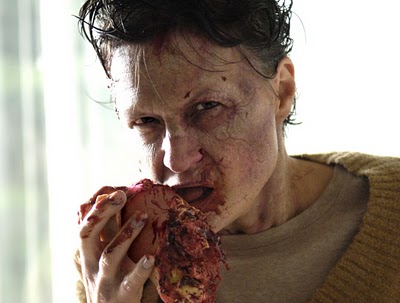TrainREC
George Romero needs to stop. It’s been about forty years since he defined the “zombie” horror sub-genre with Night of the Living Dead, and twenty-five years since he made a zombie movie that was worth a damn (Day of the Dead). Sure, he tried to make a comeback with the chronologically deficient Land of the Dead in 2005, but it was such a slick, action-packed spectacle that it became an altogether different type of film; Land also jumped the shark on Romero’s trademark social commentary, ending, literally, with an “eat the rich” bloodbath. After that movie, it was clear the writer/director had run out of fun things to do with the walking dead.
Which is why watching 2007’s Diary of the Dead was such a chore. Romero rightly believed that his franchise could use some updating; he was wrong to assume that (poorly) aping The Blair Witch Project was a good creative decision.
The conceit of Diary is that it’s a film cut together using footage taken by University of Pittsburgh (Ontario campus) students in the first days of the zombie apocalypse. This collection of hip, ridiculously attractive kids are making a mummy movie out in the woods when the first reports of zombie attacks come in over the radio. Soon they’re driving a Winnebago across the state—with their drunkard professor in tow—trying to reach their respective homes, capturing everything on a pair of what look to be big, clunky TV cameras.
Diary of the Dead has three major problems. The first two are the acting and dialogue, which make the movie nearly unwatchable. The group of kids tries way too hard to bring really bad writing to life; it’s as if they believe Romero’s monologues about pervasive media (“If it’s not on camera, it isn’t real”) are too profound to be understood by the audience, so they over-emphasize EVERYTHING. The constant asides and obviousness bog down the film’s first hour, which might have been okay if the third issue were not so glaring.
Whereas Romero’s first three zombie movies used amazingly gruesome practical effects, Diary of the Dead suffers from an over-reliance on CG gore. Worse yet, one can tell that the digital effects ate up so much of the budget that the practical stuff was apparently left to half-drunk interns. All of the gunshots-to-the-head look like they were generated with the default settings of an After Effects plug-in, and the zombie makeup and eviscerated body cavities could have been pulled from behind the counter of a costume store. Part of the joy of watching the original zombie pictures was marveling at how wizards like Tom Savini and Greg Nicotero pulled off such believable kills; Diary comes off as a tutorial in an on-line film course.
The most frustrating part of the movie is that the last half hour is much better than anything that preceded it (including Land of the Dead). By the time the group holes up in a rich friend’s fortified mansion, most of the annoying cast has been killed off. The owner of the house, Ridley, has gone insane and still roams the halls wrapped in the mummy costume from their movie. It’s here that Romero recaptures some of the claustrophobic magic of Night of the Living Dead; he even makes his media concept work, via omnipresent surveillance cameras, which are put to good use in the story. However, not even the last act is immune from idiocy, as the script calls on the characters to act in ways that defy belief for the sake of padding a pretty slim run-time.
In the years since Diary of the Dead, two films have come along and fared much better with the concept. Cloverfield set the bar for the authentic-feeling “found footage” monster movie (I thought the characters were kind of annoying until I watched Diary), and Paranormal Activity dialed back the visceral shocks in favor or more subtle scares. What the creators of both films understood is that the foremost point of a horror movie is to take the audience on a terrifying, believable ride; it’s not to hit them over the head with generic anti-establishment ideas and rely on the “gee-whiz” niftiness of modern technology.
George Romero has been known to complain about studios not giving him enough money to make the really big zombie movies he has in his head. Based on his last two pictures, I’d say they’re justified in holding back. Romero needs to revisit the simplicity of Night, Dawn, and Day. He knows how to direct tense scenes and get great performances from real (read: adult) actors, and it was the lack of money that led to some of the most memorable splatter moments in horror history—because his crew had to be inventive, instead of simply able to press a “Render” button. If he decides to work in the zombie genre again, I would suggest that he direct someone else’s material; specifically, Max Brooks’s superb novel, World War Z. Otherwise, he really should just stop.
Note: Perhaps the worst offense in Diary is the sloppiness of one particular scene in which the kids encounter a black militia that has taken over a small town. Their leader claims that anyone “without a natural sun tan” fled when the outbreak began. Yet, ten minutes later, this smiley, creepy looking white guy is helping our filmmaking heroes load canned goods into their mobile home. This makes less sense than the movie-length suspension of disbelief that a guy would not once put down his camera to help people (including his friends) in immediate danger—a problem Cloverfield solved a year later.


